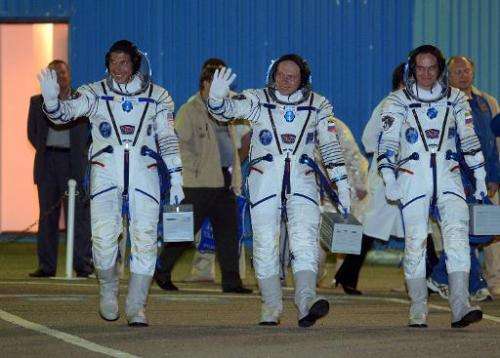L-R: Members of the International space crew, American astronaut Michael Hopkins and Russian cosmonauts Oleg Kotov and Sergei Ryazansky walk to their bus after at the Baikonur cosmodrome on September 25, 2013.
An American and two Russians blasted off Thursday for the International Space Station atop a Soyuz rocket that will slash more than a day off the usual travel time.
Michael Hopkins of NASA and Oleg Kotov and Sergei Ryazansky of Russia took off without a hitch from the Baikonur space centre that Moscow leases from Central Asia's ex-Soviet republic of Kazakhstan.
"Everything went according to plan. Everything went as expected," NASA's official flight commentator announced via a web feed after the Soyuz reached orbit about 10 minutes into its flight.
The capsule will only orbit the Earth four times as opposed to the usual 30 under a technique originally devised in the Soviet era but only adopted on a regular basis in the past year.
Scientists and space travellers had long weighed the benefits of such a sprint run.
The longer flight allows crew members to get better acclimated to the stresses of space while also testing their physical endurance—the ride takes a full 48 hours.
The shortcuts were abandoned after a few trial runs by the Soviet Union because one cosmonaut because so violently ill during the voyage that mission control at one point feared for his life.
But two such quick trips were successfully completed earlier this year and Russia decided to repeat the experience with a view to making them standard for future travel to the ISS.
The latest mission will be highlighted by the expected November 7 stopover on the ISS of a torch—left unlit for safety reasons—used during the relay ceremony for the 2014 Olympic Winter Games that Russia will be hosting in the port city of Sochi.
The new team will be joining Russian commander Fyodor Yurchikhin and his two flight engineers—Karen Nyberg of NASA and Italian Luca Parmitano of the European Space Agency.
The four-month stay of those three has been more eventful than they might have liked.
Parmitano suffered a scare during a spacewalk on July 16 when his helmet began to fill with an unidentified liquid.
"I feel that the temperature of the liquid is too cold to be sweat and above all I have the distinct sensation it is increasing in volume," Parmitano later wrote in a gripping present-tense account of the incident in a post on the European Space Agency website.
He described being blinded and suffocated as he struggled to make his way back to the airlock.
The Italian—on only his second spacewalk—said communications were also breaking apart as the water began covering his headphones and he struggled to hear instructions from NASA mission control in Houston.
NASA is probing whether the leak may have come from the liquid cooling ventilation system in the spacesuit
Russia meanwhile is struggling to prove to the world's other spacefaring nations that its mostly Soviet-designed systems are reliable enough to continue humans' conquest of space.
The 2011 retirement of the US Space Shuttle programme made Soyuz the world's last remaining manned link with the ISS.
But Russia has been recently blighted by a growing string of space failures that include the July 2 explosion shortly after takeoff from Baikonur of an unmanned Proton-M rocket.
The accidented prompted Russian Prime Minister Dmitry Medvedev to formally reprimand Russian Space Agency (Roscosmos) chief Vladimir Popovkin—a signal that his job was not safe.
The trio already in space who will be joined by the latest crew are due to return to Earth on November 11 and leave Kotov as commander of the expedition.
The Soyuz TMA-10M capsule is scheduled to dock to the ISS at 0248 GMT.
© 2013 AFP
























